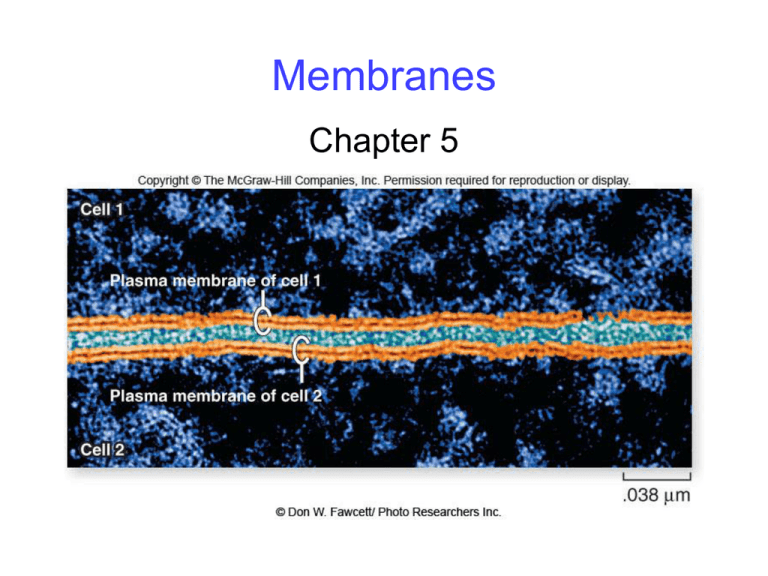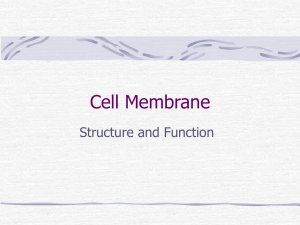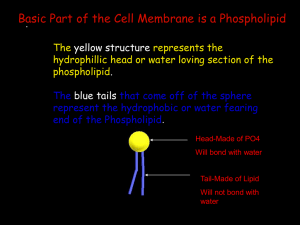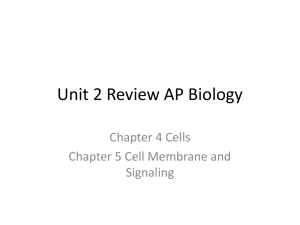BIO 103 - Membranes
advertisement

Membranes Chapter 5 Membrane Structure fluid mosaic model: Cellular membranes have 4 components: 1. phospholipid bilayer 2. transmembrane proteins 3. interior protein network 4. cell surface markers 2 3 4 Phospholipids Phospholipid structure consists of -glycerol – a 3-carbon polyalcohol acting as a backbone for the phospholipid -2 fatty acids -phosphate group 5 6 Phospholipids fatty acids are nonpolar and hydrophobic (“water-fearing”). phosphate group is polar and hydrophilic (“water-loving”). Spontaneously form micelles 7 8 Membrane Proteins Membrane proteins have various functions: 1. transporters 2. enzymes 3. cell surface receptors 4. cell surface identity markers 5. cell-to-cell adhesion proteins 9 10 Membrane Proteins Peripheral membrane proteins -anchored to a phospholipid in one layer of the membrane 11 12 Membrane Proteins Integral membrane proteins -span the lipid bilayer (transmembrane proteins) -can create pores through the membrane 13 14 Passive Transport Passive transport: movement of molecules through the membrane -no energy is required -molecules move in response to a concentration gradient Diffusion is movement of molecules from high concentration to low concentration 15 16 Passive Transport Selective permeability: integral membrane proteins allow the cell to be selective about what passes through the membrane. 17 18 Passive Transport Channel proteins have a polar interior allowing polar molecules to pass through. Channel proteins include: -ion channels allow the passage of ions which are associated with water -gated channels are opened or closed in response to a stimulus (chemical or electrical) 19 Passive Transport Carrier proteins bind to a specific molecule to facilitate its passage Facilitated diffusion is movement of a molecule from high to low concentration with the help of a carrier protein. -is specific -is passive -saturates when all carriers are occupied 20 Passive Transport Osmosis is the movement of water from an area of high to low concentration of water -movement of water toward an area of high solute concentration (Lower Water Concentration) 21 22 Passive Transport When 2 solutions have different osmotic concentrations -the hypertonic solution has a higher solute concentration -the hypotonic solution has a lower solute concentration Osmosis moves water toward the hypertonic solution. 23 HYPERTONIC: cell shrivels ISOTONIC: no change HYPOTONIC: cell swells 25 Active Transport Active transport -requires energy – ATP is used directly or indirectly to fuel active transport -moves substances from low to high concentration -requires the use of carrier proteins 26 Example: Sodiumpotassium (Na+-K+) pump in neurons 27 Bulk Transport Endocytosis movement of substances into the cell when the plasma membrane envelops food particles and liquids. 1. phagocytosis – particulate matter 2. pinocytosis – only fluid 3. receptor-mediated endocytosis – specific molecules are taken in after they bind to a receptor (Example – Iron Intake) 28 29 30 31 Bulk Transport Exocytosis: material is discharged from the cell. -vesicles in the cytoplasm fuse with the cell membrane and release their contents to the exterior of the cell -plants: to export cell wall material -animals: to secrete hormones, neurotransmitters, digestive enzymes 32 33










